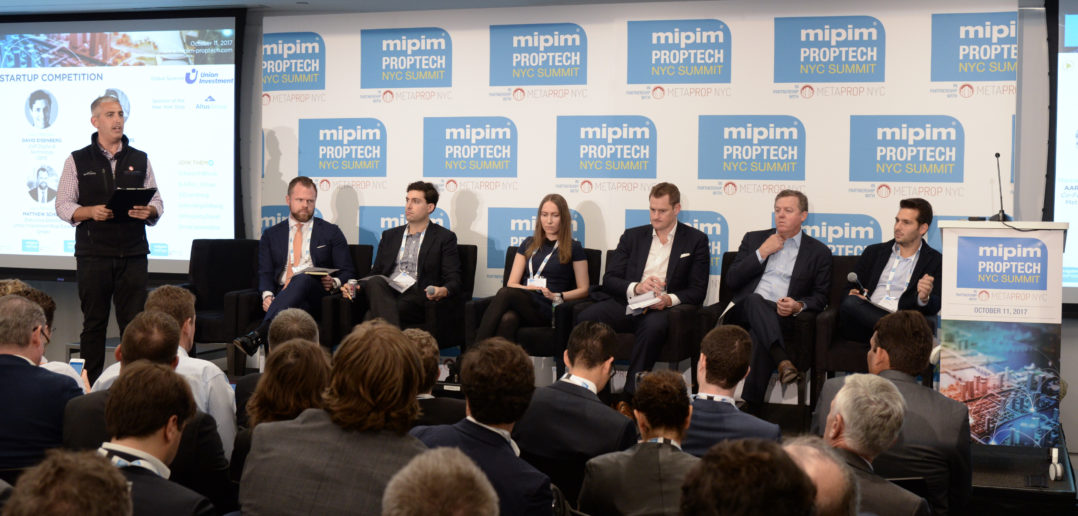This marks the third year for the MIPIM PropTech global startup competition. Today, at MIPIM PropTech, 8 finalists in the New York leg of the Startup Competition, pitched their concepts. These finalists were selected among hundred’s of property startups, as offering the best solutions for real estate owners today.
Kaarta – Kevin Dowling
Kaarta maps the world in real time. Data and information is heavily siloed in the real estate world these days and getting a 3D map of a property or space can be very difficult. In addition, we lose a lot of information over time. Information needs to be updated to remain accurate and relevant and very often it is not.
By using point cloud technology Kaarta can allow operators and contractors accurately map spaces in 15 minutes or less. In some cases, the high accuracy even allows them to skip making a full high res 3D model. “By using the Kaarta “Contour” camera we built a model of the entire Stanford main quad area in 15 minutes. We built a full-scale 3D model of the Convene event space in a similar amount of time. Once you’re done walking the area you want mapped, the map is created instantly.”
Questions from the Judges:
Robert Corteau: Where will you be in 5 years?
Kevin Dowling: Probably in China and Asia. They are adopting this kind of technology very quickly.
Dan Hughes: How do you protect this from mobile phone mapping technology?
Kevin Dowling: Visually, the mobile phone technology can work, however it’s hard to really capture detailed 3D geometry with that technology. You need a high res purpose built camera like the “Contour.”
Maria Seredina: How long does it take to onboard a new user?
Kevin Dowling: About 15 min for basic use, like the Stanford case and the Convene space and just a couple of hours for advanced use in a tight stairwell for example.
Matthew Scholl: What is the economic value?
Kevin Dowling: Speed and accuracy is the biggest value. Kaarta creates a full high res 3d map in minutes.
MC Smart Controls – Lawrence Lebeau
In the US alone, 1 Trillion gallons of water are lost due to water leaks. This is also the leading cause of property damage.” An estimated $5B is spent per year repairing water damage from leaks. In addition, millions of gallons of irrigation water area also lost to leakage.
The FL-1000 can detect frozen or cracked pipes and is incredibly easy to install. It’s the only leakage detection device that operates within the plumbing system and will soon be able to shut off leaking pipes remotely. “The FL-1000 is patented technology and is the only system built directly into the pipes. Our competitors off sensors that detect leaks once they have begun, but by that time, you already have a flood.” There are also various incentives for devices hooked up directly to pipes rather than outside the system. “Our cloud based water management system is scalable to 10,000 people or devices and manages irrigation based on weather patterns.”
Questions from the Judges:
Dan Hughes: What is the cost?
Lawrence Lebeau: $129 per unit.
Dan Hughes: What is the enterprise cost?
Lawrence Lebeau: There is a residential version and an enterprise version. The enterprise version is more expensive of course. It can handle larger gauge pipes and can interconnect many devices.
Maria Seredina: what is your margin on home model?
Lawrence Lebeau: We went with a newly developed Wi-Fi module that actually dropped the base production cost to $19-20.
Robert Courteau: What is the real differentiation from the competition?
Lawrence Lebeau: We have a solid patent on the in-system technology. You can’t protect everything forever but our competition is actually coming to us for advice as they are looking at a 3yr runway to deliver a competitive product.
David Eisenberg: How does this scale?
Lawrence Lebeau: We are partnering with Google Nest to have a part of that existing pipeline.
PlanRadar: Sander van de Rijdt
“Every construction project has defects. You need detailed documentation of these defects so you can fix them but this process is incredibly inefficient with multiple steps for each error. Consider how long it would take to document and rectify a project with hundreds of errors?”
The solution is PlanRadar.
You simply upload your blueprint to our mobile software, and then, as you walk a site you can pin defects and send them out in real time, on the actual blueprint so they can quickly get rectified.
PlanRadar saves an average of 7 working hours every week. “We are targeting builders, asset managers, construction companies, etc. We also have customers from ship building, container design, and others. We already have existing customer base that uses our technology on 5000 or more errors a week.” Onboarding takes less than 10 minutes for new users.
Questions from the Judges:
Matthew Scholl: How do you price?
Sander van de Rijdt: A license is $1000/yr
Robert Corteau: What are you worried about?
Sander van de Rijdt: Speed. There are others in this space so we need to grow fast, expand, and innovate even faster.
Dan Hughes: how much of a barrier are local standards to scaling globally.
Sander van de Rijdt: Thankfully the German rules are very strict so we actually do not have a problem with this.
Maria Seredina: How does this relate to the US market?
Sander van de Rijdt: The US market is the biggest in the world but they already have some players in this space. We will transfer to the US but at the moment we are focused on Europe.
David Goldberg: Pro-core and plan grid are stated competitors, what will keep them at bay?
Sander van de Rijdt: Their market is the US but I don’t see them coming to Europe with all the language barriers and regulations. They will probably go to Asia before Europe.
RealAtom – Yulia Yaani
RealAtom is like Lending Tree for commercial loans. If you want to finance a commercial building traditionally, it takes weeks or months. “We match lenders with commercial borrowers in real time and have lenders compete for your business for a fraction of the price.”
RealAtom has closed loans over holiday weekends in two business days. The wait time is a fraction of traditional methods. We have 400 registered lenders, over $450M of loan requests and have transacted over $660k.
The future of commercial lending is RealAtom.
Questions from Judges:
Matthew Scholl: What is average loan size?
Yulia Yaani: $1-60M. We are loan type agnostic so these loans span the entire CRE space.
Maria Seredina: What % of loans get no engagement at all? Is there a way to screen?
Yulia Yaani: Our conversion rate is better than the industry average of 25%. At this point we are allowing all requests on our platform but in the future, we will screen loan requests that we know will not get funded in an effort to save the borrower’s time.
Dan Hughes: What is the differentiator between you and competitors?
Yulia Yaani: We are scalable. Many competitors are trying to build a digital, mortgage specific brokerage, we are not constrained by this and are currently lending across all sectors of the commercial real estate spectrum.



